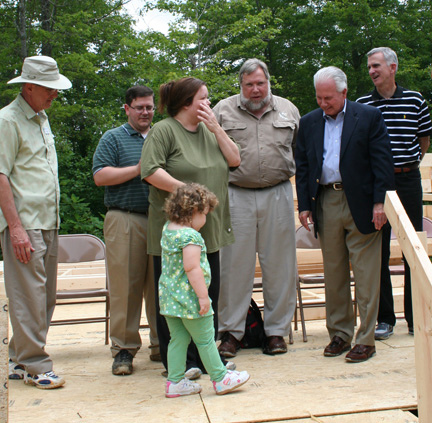USDA Direct Home Loan Program, Neighbors, Combine to Make a Homeownership Dream into a Reality
Written by Katherine Belcher, Kentucky USDA Public Information Coordinator
As USDA kicked off National Home Ownership Month, more than 115 volunteers from 25 churches across the state of Kentucky gathered in a vacant lot in Whitley City to build a house for a woman many of them have never met. They are camping near the construction site, working long days to see that the project is completed by the home’s dedication date of June 19.
In Kentucky’s first homeownership event of the 2010 campaign, Rural Development staff joined representatives from other state and federal agencies, non-profit groups and community leaders to participate in the opening ceremony for the “Extreme Build” that will provide a new home for a very deserving, hard-working single mom.
Kristi Wilson was chosen to be the recipient of the fifth annual Extreme Build in McCreary County by the Kentucky Baptist Fellowship (KBF) – because of the struggles she has overcome in her life and her dedication to providing the best life possible for her two children. McCreary County is one of the state’s 43 persistent poverty counties.
KBF volunteers will build a new home for Wilson, who received a Rural Development Direct Loan to make the purchase and other assistance from local non-profits and state and federal agencies.
Wilson was overwhelmed and awed by the number of people that have shown up to assist in building her new house from the ground up.
“It’s amazing that you can find so many people with that big of a heart,” said Wilson. “It’s answering my kids’ prayers. I wanted this for my kids – I want them to have a home.”
After the home’s foundation was laid, a crane placed an 8,000 pound “core” unit containing a pre-fabricated kitchen, bath and utility room onto it. The core is pre-wired and the unit was provided by Kentucky Highlands Investment Corporation and built off-site by residents at Kentucky Foothills Academy – a licensed, residential treatment facility for state-committed youth.
As many of the guest speakers reiterated throughout the opening ceremony, this project is truly a partnership among numerous people and local, state and federal agencies – all working to make possible one woman’s dream of providing her family with a safe, affordable decent place to live.
It was truly an honor and privilege to be a part of it.

Kentucky State Director Tom Fern (second from right) congratulates new homeowner Kristi Wilson, who was selected
by the Kentucky Baptist Fellowship as the recipient of this year’s McCreary County Extreme Build.

A crane is used to place a pre-fabricated unit consisting of a kitchen, bathroom and utility room
onto the foundation of Kristi Wilson’s new home.


